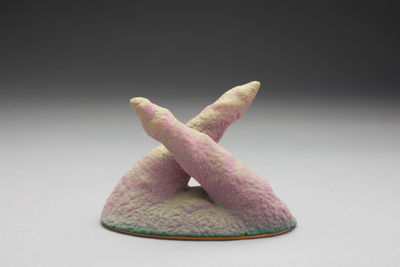Ron Nagle
Title: Thataway
As playful with the plasticity of language as with clay, Nagle’s love of simple, sometimes crude, humour is solidified in ‘Thataway’ — a harmony of confusion and misdirection as two fingers point to two opposite directions. The unnatural effect of the blushing, tinted colours further accentuates a creeping sense of ambiguity. The primal, earthly state of clay is further devolved by the sculpture’s true model; dog droppings — and the piece subtly consecrates the waste, the ability for art to veil and make sacred any object of any origin through formalism, and becomes a joke token of the relationship between animal and doting owner happy to pick up after it.
Title: The Mingler
In Ron Nagle’s “The Mingler,” simple, geometric forms combine with vibrant colors and contrasting textures to create an object of great complexity. “The Mingler” is part of a series of just ten works created in 2003 that reference snuff bottles—diminutive, intricately decorated, lidded vessels innovated in China during the Qing dynasty. Snuff bottles were used for the storage and dispensation of powdered tobacco, which was believed to have medicinal properties. Like a traditional snuff bottle, “The Mingler” is small in scale and features a glossy, button-like top. While Nagle’s treatment of the glaze hints at an oozing, molten elixir, the work eludes function. The smooth green glaze collects in a viscous ribbon as it approaches the base of the object, abruptly transitioning in color from white to a candy apple red. The piece is composed of two geometric volumes that hover delicately over a thin base, a common device in Nagle’s work.



